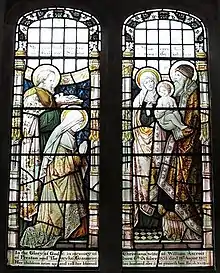Shrigley and Hunt
Shrigley and Hunt was an English firm which produced stained-glass windows and art tiles.
 Shrigley and Hunt window in St Oswald's Church, Grasmere | |
| Industry | Stained-glass windows |
|---|---|
| Founded | 1750s in Lancaster, Lancashire |
| Defunct | 1982 |
| Headquarters | |
Key people |
|
History
The business began in the 1750s when Shrigley's was a painting, carving and gilding firm in Lancaster, Lancashire.
In 1868, control of Shrigley's was passed to Arthur Hunt, a Londoner, who ran a stained glass and decorating business in the south of England. Hunt had worked under designer Henry Holiday at the firm of Heaton, Butler & Bayne. Holiday influenced Hunt to create brighter, more realistic and more understandable figures and stories from the bible. Hunt's chief designers were Carl Almquist who had also studied under Holiday, and E. H. Jewitt.[1]
From 1878, the firm became known as Shrigley and Hunt, with premises on Castle Hill, Lancaster opposite the main gate of Lancaster Castle. The new company also had a showroom in London.[2]
Hunt died in 1917 and leadership passed to Joseph Fisher. After World War II the company moved to West Road, Lancaster; fire destroyed much of those premises in 1973. The firm closed with Fisher's death in 1982.[1]
Shrigley and Hunt made windows for many churches, including the Priory Church of St Mary in Lancaster and St Paul's Church in Scotforth. Their work can also be found throughout the UK and in Europe.
As well as stained glass, Shrigley and Hunt made ceramic tiles; in the late 19th century these formed an important part of the income of the company. Some of the tiles can be seen still in situ outside their former workshop on Castle Hill. The firm also produced craft decoration including stencilled wall and ceiling decoration.
Lancaster City Museum has a significant holding of Shrigley and Hunt material. This includes two panels by E. L. Eaton, a stained-glass window and its cartoon in the design of John O'Gaunt, several negatives showing posed figures for stained glass artists to copy, and two painted vases by William Lambert.[3] Most other records of Shrigley & Hunt were lost in a fire.[4]

Works
Dated works
- The Ascension at St Thomas' Church, Garstang (1877)[5]
- North aisle window at St. Paul's Church, Bedford: figures of faith, fortitude and charity (1885)
- Three Marys at St James's Church, Gerrards Cross, Buckinghamshire (1894)
- Last Supper at St. Mary's Church, Higham Ferrers, Northamptonshire (1897)
- Rhodes and Parkinson memorial windows in transepts of Bradford Cathedral (1898)
- Stencilled ceiling decoration in the 1901 Lloyd's Register building at 71 Fenchurch Street in London, designed by Thomas Collcutt[6]
- Annunciation at St Mary's Church, Amersham, Buckinghamshire (1905)
- Two windows at Holy Trinity Church, Blackpool (1909)[7]
- East window at St. Andrew 's Church, Dent (1912)
- North aisle window and west window at St Michael's Church, St Michael's on Wyre (1936)[8]
- Chancel window dedicated to the fallen of 1939-45 at, Mountjoy Parish Church,Cappagh Co.Tyrone (c.1950)[9]
- The Annunciation at St Oswald's Church, Preesall (c. 1971)[10]
- Gift of Tongues at St Oswald's Church, Preesall (c. 1972)[10]
Undated works
- St. Boniface Parish Church, Bonchurch, Isle of Wight. West Windows. St. Faith and St. John the Baptist.
- Several signed windows in the Parish Church of St Clement Urmston, Manor Avenue, Urmston M41 9JZ including a domestic scene describing the story of Martha and Mary; also a number of other windows which are attributed to Shrigley and Hunt
References
Footnotes
- Stained Glass in Wales: Shrigley & Hunt (1874-1982)
- Lancaster University Centre for North West Regional Studies
- Lancaster Guardian article on Shrigley & Hunt exhibition
- Saunders, M. (July 2008), "Appreciating Victorian and Arts and Crafts Stained Glass: A Battle Half Won", Ecclesiology Today, 40, p. 88
- Waters, p. 74
- Lloyd's Register in London pps. 9, 13, 20
- Waters, p. 73
- Waters, p. 78
- Art Glass Stained Glass Studio, restoration and conservation. Mr P Coyle.
- Waters, p. 77
- Bibliography
- Waters, Bill (2003). Stained Glass from Shrigley & Hunt of Lancaster and London. Lancaster: University of Lancaster. ISBN 1-86220-140-4.
- Armstrong, Barrie and Wendy (2005). The Arts and Crafts Movement in the North West of England: A Handbook. Wetherby: Oblong. pp. 262–263.
- Harrison, Martin (1980). Victorian Stained Glass. London. p. 55.
External links
- Silent footage of window manufacturing at Shrigley & Hunt c.1948 Produced by Sam Hanna, Burnley (Vimeo - North West Film Archive)
- Stained Glass in Wales: Shrigley & Hunt (23 images)